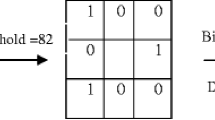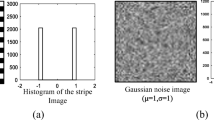Abstract
Local structural information is crucially important for human visual system to perceive natural scenes. Recent years, a variety of local image structure description methods have been proposed for the artificial modeling of visual perception. Although existing local image structure descriptors have shown successful performances, one general limitation is their numerical instability caused by ignoring the information of the spatial correlation of local orientation. In this paper, we propose a local image structure descriptor by modeling the anisotropic mechanism in the primary visual cortex. In particular, the pixel-wise anisotropy values of a given image are calculated by pseudo-Wigner-Ville distribution (PWVD) and Rényi entropy. Then the excitatory/inhibitory interactions among visual neurons in the local receptive field are modeled by measuring the similarities between their anisotropies. By mapping visual neurons to image pixels, the correlation between a central pixel and its local neighbors can be represented by a binary pattern which is named as local anisotropic pattern (LAP). Experimental results on texture classification verified that the proposed LAP has satisfactory texture classification accuracy, rotation invariance, and noise robustness; experimental results on no-reference image quality assessment demonstrated that the proposed LAP achieves state-of-the-art performance in objective evaluation of the perceptual quality of natural image, and this reflects that LAP can accurately represent the degradation of local image structure.











Similar content being viewed by others
References
Ahonen T, Hadid A, Pietikäinen M (2006) Face description with local binary patterns: Application to face recognition. IEEE Trans Pattern Anal Mach Intell 28(12):2037–2041
Berry Jr. JR, Goutsias J (1991) A comparative study of matrix measures for maximum likelihood texture classification. IEEE Trans Syst Man Cybern 21(1):252–261
Campbell FW, Kulikowski JJ (1966) Orientational selectivity of the human visual system. J. Physiology 187(2):437–445
Camp-Valls G, Bruzzone L (2009) Kernel methods for remote sensing data analysis. Wiley, New York
Chang C, Lin C LIBSVM: A library for support vector machines. [Online]. Available: http://www.csie.ntu.edu.tw/~cjlin/libsvm/
Cristobal G, Schelkens P, Thienpont H (2011) Optical and digital image processing: Fundamentals and applications. Wiley, NY, USA
Fan K-C, Hung T-Y (2014) A novel local pattern descriptor - local vector pattern in high-order derivative space for face recognition. IEEE Trans Image Process 23(7):2877–2891
Fieguth P (2011) Statistical image processing and multidimensional modeling. Springer-Verlag, NY, USA
Friston K (2010) The free-energy principle: A unified brain theory? Nat Rev Neurosci 11(2):127–138
Furmanski CS, Engel SA (2000) An oblique effect in human primary visual cortex. Nat Neurosci 3:535–536
Gabarda S, Cristóbal G. (2007) Blind image quality assessment through anisotropy. J Opt Soc Am A 24(12):B42–B50
Gerrow K, Triller A (2010) Synaptic stability and plasticity in a floating world. Curr Opin Neurobiol 20(5):631–639
Ghosh K, Sarkar S, Bhaumik K (2009) A possible mechanism of stochastic resonance in the light of an extra-classical receptive field model of retinal ganglion cells. Biol Cybern 100(5):351–359
Guo Z, Zhang L, Zhang D (2010) Rotation invariant texture classification using LBP variance (LBPV) with global matching. Pattern Recognit 43(3):706–719
Guo Z, Zhang L, Zhang D (2010) A completed modeling of local binary pattern operator for texture classification. IEEE Trans Image Process 19(6):1657–1633
Hafiane A, Palaniappan K, Seetharaman G (2015) Joint adaptive median binary patterns for texture classification. Pattern Recognit 48(8):2609–2620
Heikkilä M, Pietikäinen M (2006) A texture-based method for modeling the background and detecting moving objects. IEEE Trans Pattern Anal Mach Intell 28 (4):657–662
Knill DC, Pouget R (2004) The bayesian brain: The role of uncertainty in neural coding and computation. Trends Neurosci 27:712–719
Kodituwakku S, Kennedy RA, Abhayapala TD (2010) Radial function based kernel design for time-frequency distributions. IEEE Trans Signal Process 58 (6):3395–3400
Kong H, Sarma SE, Tang F (2013) Generalizing Laplacian of Gaussian filters for vanishing-point detection. IEEE Trans Intell Transp Syst 14(1):408–418
Krisanova EN, Sadovsky MG (2002) Entropy approach in the analysis of anisotropy of digital images. Open Syst Inf Dyn 9(3):239–250
Larson EC, Chandler DM (2010) Most apparent distortion: Full reference image quality assessment and the role of strategy. J Electron Imag 19(1):011006
Lebrun M, Colom M, Morel J. -M. (2015) Multiscale image blind denoising. IEEE Trans Image Process 24(10):3149–3161
Liu L, Dong H, Huang H, Bovik AC (2014) No-reference image quality assessment in curvelet domain. Signal Process -Image Commun 29(4):494–505
Lorenzi L, Mercier G, Melgani F (2013) Support vector regression with kernel combination for missing data reconstruction. IEEE Geosci Remote Sens Lett 10 (2):367–371
Ma L, Crawford MM, Tian J (2010) Local manifold learning-based k-nearest-neighbor for hyperspectral image classification. IEEE Trans Geosci Remote Sens 48(11):4099–4109
Ma L, Crawford MM, Yang Y, Guo Y (2015) Local-manifold-learning-based graph construction for semisupervised hyperspectral image classification. IEEE Trans Geosci Remote Sens 53(5):2832– 2844
Maloney RT, Clifford CWG (2015) Orientation anisotropies in human primary visual cortex depend on contrast. Neuroimage 119:129–145
Mangasarian OL, Musicant DR (2000) Robust linear and support vector regression. IEEE Trans Pattern Anal Mach Intell 22(9):950–955
Mannion DJ, McDonald JS, Clifford CWG (2010) Orientation anisotropies in human visual cortex. J Neurophysiol 103(6):3465–3471
Michmizos D, Koutsouraki E, Asprodini E, Baloyannis S (2011) Synaptic plasticity: A unifying model to address some persisting questions. Int J Neurosci 121 (6):289–304
Mittal A, Moorthy AK, Bovik AC (2012) No-reference image quality assessment in the spatial domain. IEEE Trans Image Process 21(12):4695–4708
Mouats T, Aouf N, Richardson MA (2015) A novel image representation via local frequency analysis for illumination invariant stereo matching. IEEE Trans Image Process 24(9):2685–2700
Murala S, Maheshwari RP, Balasubramanian R (2012) Local tetra patterns: A new feature descriptor for content-based image retrieval. IEEE Trans Image Process 21(5):2874–2886
Ojala T, Pietikäinen M., Mäenpää T (2002) Multiresolution gray-scale and rotation invariant texture classification with local binary patterns. IEEE Trans Pattern Anal Mach Intell 24(7):971–987
Ojala T, Mäenpää T, Pietikäinen M, Viertola J, Kyllönen J, Huovinen S (2002) Outex - new framework for empirical evaluation of texture analysis algorithms. In: Proceedings International Conference Pattern Recognition, pp 701–706
Pan Z, Fan H, Zhang L (2015) Texture classification using local pattern based on vector quantization. IEEE Trans Image Process 24(12):5379–5388
Park SH, Cha K, Lee S-H (2013) Coaxial anisotropy of cortical point spread in human visual areas. J Neurosci 33(3):1143–1156
Ponomarenko N, Lukin V, Zelensky A, Egiazarian K, Carli M, Battisti F (2009) TID2008-A database for evaluation of full-reference visual quality assessment metrics. Adv Modern Radio Electron 10(4):30–45
Rahtu E, Heikkilä J, Ojansivub V, Ahonenc T (2012) Local phase quantization for blur-insensitive image analysis. Image Vis Comput 30(8):501–512
Rényi A (1961) On measures of entropy and information. In: Proceedings Berkeley Symposium Mathematics Statistics Probability, pp 547–561
Ryu J, Hong S, Yang HS (2015) Sorted consecutive local binary pattern for texture classification. IEEE Trans Image Process 24(7):2254–2265
Shannon CE (1948) A mathematical theory of communication. Bell Labs Tech J 27(3):379–423
Sheikh HR, Wang Z, Cormack L, Bovik AC LIVE image quality assessment database release 2. [Online]. Available: http://live.ece.utexas.edu/research/quality
Smola AJ, Schölkopf B. (2004) A tutorial on support vector regression. Statist Comput 14(3):199–222
Swisher JD, Gatenby JC, Gore JC, Wolfe BA, Moon C-H, Kim S-G, Tong F (2010) Multiscale pattern analysis of orientation-selective activity in the primary visual cortex. J Neurosci 30(1):325–330
Tamura H, Mori S, Yamawaki T (1978) Textural features corresponding to visual perception. IEEE Trans Syst Man Cybern 8(6):460–472
Tan X, Triggs B (2010) Enhanced local texture feature sets for face recognition under difficult lighting conditions. IEEE Trans Image Process 19(6):1635–1650
Vipparthi SK, Murala S, Nagar SK, Gonde AB (2015) Local Gabor maximum edge position octal patterns for image retrieval. Neurocomputing 167:336–345
Wang Z, Bovik AC (2006) Modern image quality assessment. Morgan & Claypool, San Rafael, CA
Wang Z, Bovik AC (2009) Mean squared error: Love it or leave it? IEEE Signal Process Mag 26(1):98–117
Wang Z, Bovik AC, Sheikh HR, Simoncelli EP (2004) Image quality assessment: From error visibility to structural similarity. IEEE Trans Image Process 13 (4):600–612
Wu J, Lin W, Shi G (2014) Image quality assessment with degradation on spatial structure. IEEE Signal Process Lett 21(4):437–440
Wu J, Lin W, Shi G, Zhang Y, Dong W, Chen Z (2015) Visual orientation selectivity based structure description. IEEE Trans Image Process 24(11):4602–4613
Wright J, Ma Y, Mairal J, Sapiro G, Huang T, Yan S (2010) Sparse representation for computer vision and pattern recognition. Proc IEEE 98(6):1031–1044
Xu Y, Zhao Y, Jin C, Qu Z, Liu L, Sun X (2010) Salient target detection based on pseudo-Wigner-Ville distribution and Rényi entropy. Opt Lett 35 (4):475–477
Yamada K, Miyawaki Y, Kamitani Y (2015) Inter-subject neural code converter for visual image representation. Neuroimage 113:289–297
Yeffet L, Wolf L (2009) Local trinary patterns for human action recognition. In: Proceedings IEEE International Conference Computer Vision, pp 492–497
Zhang Z-C (2015) Unified Wigner-Ville distribution and ambiguity function in the linear canonical transform domain. Signal Process 114:45–60
Zhang B, Chen S (2013) A comparative study on local binary pattern (LBP) based face recognition: LBP histogram versus LBP image. Neurocomputing 120:365–379
Zhang Y, Chandler OM (2013) No-reference image quality assessment based on log-derivative statistics of natural scenes. J Electron Imaging 22(4):043025
Zhang B, Gao Y, Zhao S, Liu J (2010) Local derivative pattern versus local binary pattern: Face recognition with high-order local pattern descriptor. IEEE Trans Image Process 19(2):533–544
Zhang L, Zhang L, Mou X, Zhang D (2011) FSIM: A feature similarity index for image quality assessment. IEEE Trans Image Process 20(8):2378–2386
Zhang M, Muramatsu C, Zhou X, Hara T, Fujita H (2015) Blind image quality assessment using the joint statistics of generalized local binary pattern. IEEE Signal Process Lett 22(2):207–201
Acknowledgments
The authors would like to thank the editor and the anonymous reviewers for their valuable comments and suggestions to improve the quality of the paper. They would also like to thank the members at the Institute of Circuits and Systems, School of Information Science and Engineering, Lanzhou University, for valuable discussions. This work was supported by the National Natural Science Foundation of China (NSFC) under Grant 61175012 and the Fundamental Research Funds for the Central Universities of China under Grant lzujbky-2015-196.
Author information
Authors and Affiliations
Corresponding author
Rights and permissions
About this article
Cite this article
Du, S., Yan, Y. & Ma, Y. LAP: a bio-inspired local image structure descriptor and its applications. Multimed Tools Appl 76, 13973–13993 (2017). https://doi.org/10.1007/s11042-016-3779-2
Received:
Revised:
Accepted:
Published:
Issue Date:
DOI: https://doi.org/10.1007/s11042-016-3779-2




